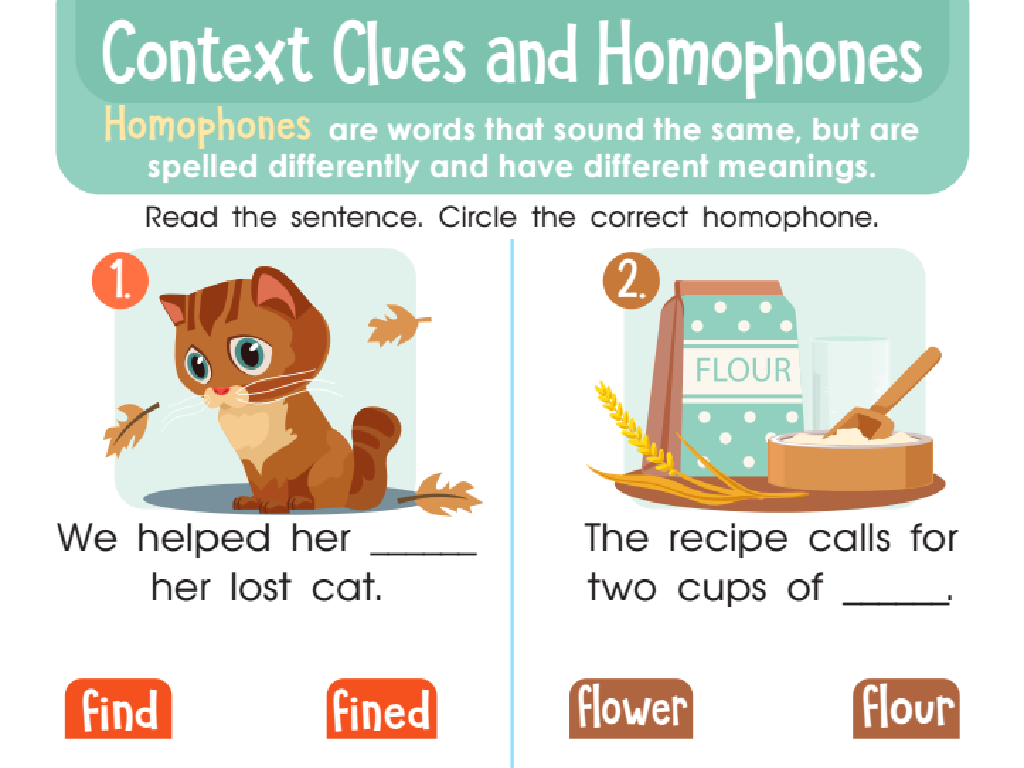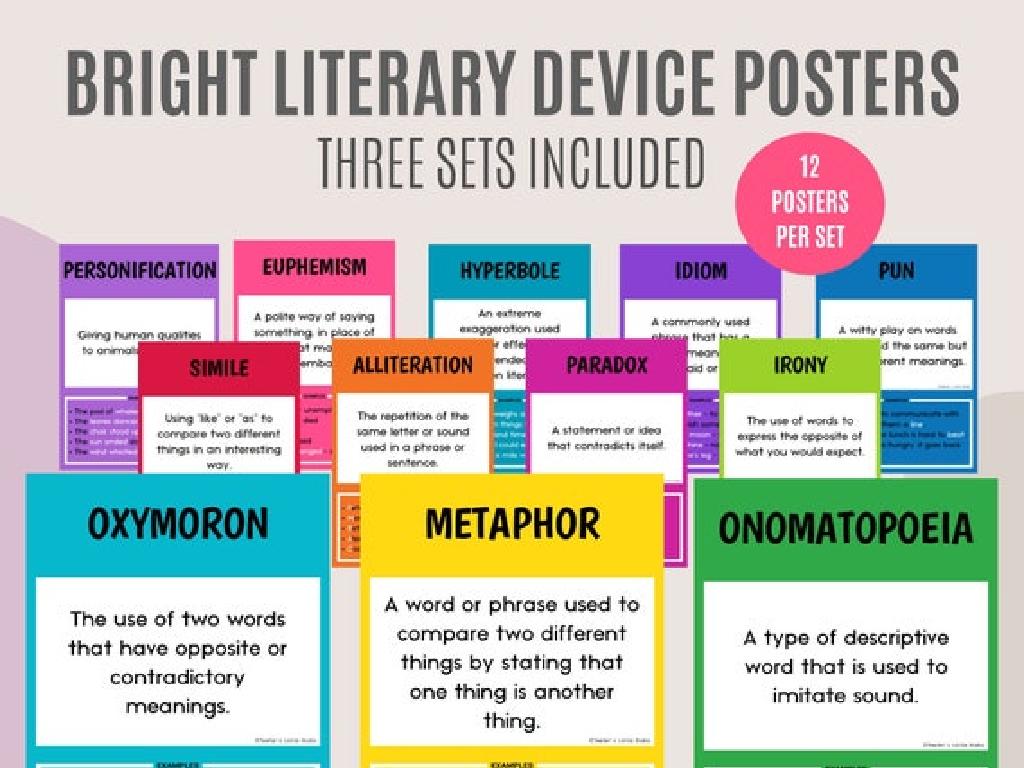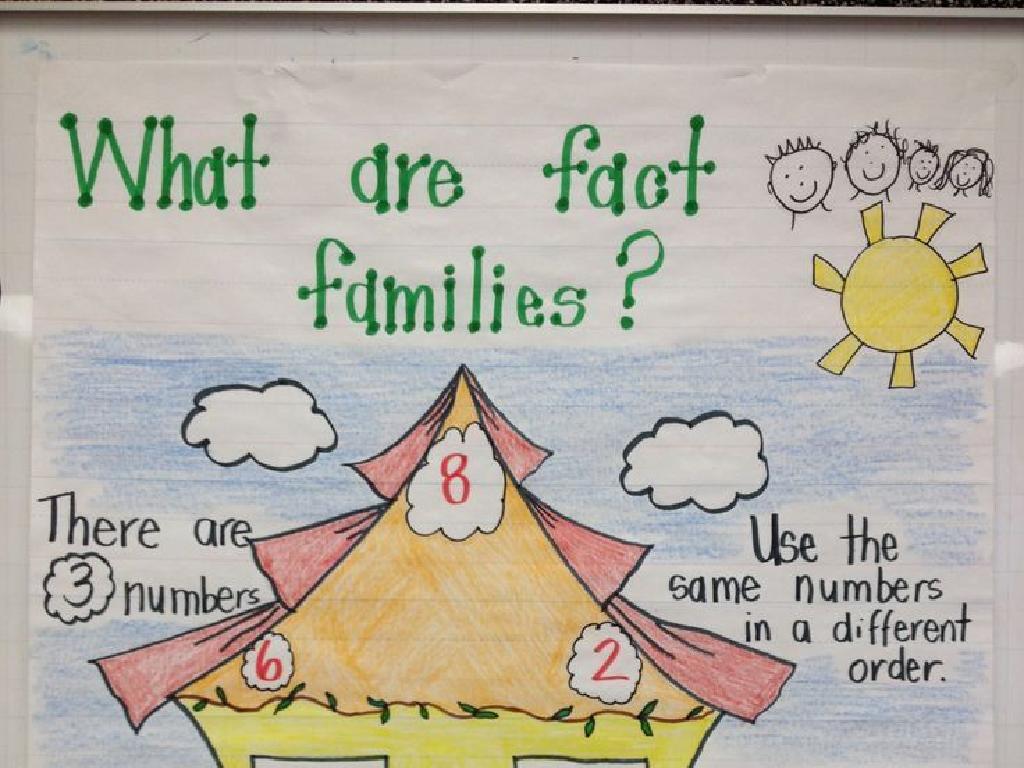Probability Of Independent And Dependent Events
Subject: Math
Grade: Eighth grade
Topic: Probability
Please LOG IN to download the presentation. Access is available to registered users only.
View More Content
Introduction to Probability
– Understanding basic probability
– Probability measures the chance of an event occurring.
– Grasping certainty and chance
– Certain events will always happen, while impossible events never do.
– Differentiating event likelihood
– Likely events have a high chance, unlikely have a low chance of occurring.
– Observing probability in life
– Weather forecasts, games of chance, and daily decisions involve probability.
|
Begin the lesson by explaining probability as a measure of how likely an event is to occur, ranging from 0 (impossible) to 1 (certain). Discuss the spectrum of event likelihood, including certain, likely, unlikely, and impossible events. Provide relatable examples such as the probability of rain (weather forecast), winning a game, or guessing a coin toss. This will help students connect the concept of probability to real-world scenarios and understand its practical applications. Encourage students to think of other examples where they encounter probability in their daily lives.
Types of Events in Probability
– Define Independent Events
– Two events are independent if the outcome of one does not affect the other
– Define Dependent Events
– Dependent events are when the outcome of one event affects the outcome of another
– Independent event examples
– Flipping a coin and rolling a die are independent; the coin toss doesn t affect the die roll
– Dependent event examples
– Drawing two cards from a deck without replacement is dependent; the first draw affects the second
|
This slide introduces students to the fundamental concepts of independent and dependent events in probability. Independent events are those where the outcome of one event does not influence the outcome of another, such as flipping a coin and rolling a die simultaneously. Dependent events are interconnected, where the outcome of one event has an effect on the outcome of the subsequent event, like drawing cards from a deck without replacement. Provide clear examples to illustrate these concepts, ensuring students understand the distinction. Encourage them to think of other examples from daily life and discuss how identifying the type of event is crucial in calculating probabilities.
Probability of Independent Events
– Define independent events
– Two events are independent if the occurrence of one does not affect the other
– Formula for probability
– The probability of both events occurring is the product of their individual probabilities: P(A and B) = P(A) * P(B)
– Calculate two events’ probability
– To find the combined probability, multiply the probability of each event occurring separately
– Example: Coin toss & die roll
– Flipping a coin (P(Heads) = 1/2) and rolling a die (P(4) = 1/6), find P(Heads and 4)
|
This slide introduces the concept of independent events in probability, where two events do not influence each other’s outcomes. The formula for calculating the probability of two independent events occurring together is presented. Students should understand that the probability of both events occurring is found by multiplying their individual probabilities. An example is provided with a coin toss and die roll to solidify the concept. Encourage students to think of other examples of independent events and calculate probabilities to practice this concept.
Probability of Dependent Events
– Define dependent events
– Events where the outcome of one affects the other
– Impact on event probability
– Example: Card drawing
– Removing a card changes the deck for the next draw
– Formula application
– Use P(A and B) = P(A) * P(B|A) for calculation
|
Dependent events are those where the outcome of one event influences the outcome of another. For example, if you draw a card from a deck and do not replace it, the deck’s composition changes, affecting the probability of drawing a second card. This concept is crucial for students to understand how probabilities are adjusted based on prior outcomes. Use the card drawing example to illustrate this: if a King is drawn first, the chance of drawing a Queen next is different than if the King were replaced. Teach students the formula P(A and B) = P(A) * P(B|A), where P(B|A) is the probability of B occurring after A has occurred. Have students practice with different scenarios to solidify their understanding.
Calculating Complex Probabilities
– Utilize probability trees
– Visual tool for mapping event outcomes
– Step-by-step problem calculation
– Break down problems into manageable parts
– Interactive class example
– Students apply concepts in a guided activity
– Engage with complex events
|
This slide introduces students to the concept of using probability trees to calculate the probabilities of complex events. Probability trees help visualize and organize the possible outcomes of one or more events. Begin by explaining how to set up a tree with branches representing possible outcomes and their probabilities. Then, demonstrate a step-by-step approach to solving sample problems, ensuring to break down each step clearly. Engage students with an interactive example where they participate in creating a probability tree based on a scenario you provide. This activity will help solidify their understanding of the process and the calculation of probabilities for independent and dependent events. Encourage students to ask questions and discuss as they work through the example.
Practice Problems: Mastering Probability
– Solve probability problems as a class
– Apply probability formulas
– Use formulas for independent and dependent events in new scenarios
– Foster critical thinking
– Analyze and approach problems logically
– Enhance problem-solving skills
– Tackle challenging questions, find solutions
|
This slide is designed to engage students in active problem-solving and application of probability concepts. Start with a group activity to solve probability problems, reinforcing the understanding of independent and dependent events. Guide students through applying the appropriate formulas to new situations, which will help solidify their grasp of the material. Encourage them to think critically about each problem and to discuss their problem-solving strategies with the class. This collaborative approach not only enhances their mathematical skills but also promotes a deeper understanding of probability as it applies to real-world situations. Provide a variety of problems with varying levels of difficulty to challenge all students.
Class Activity: Exploring Probability with Experiments
– Conduct a probability experiment
– Record outcomes and calculate probabilities
– Tally results and use them to find the likelihood of events
– Engage in group discussions
– Discuss how outcomes compare with predictions
– Share findings with the class
– Present your group’s experiment and insights
|
This activity is designed to provide hands-on experience with probability. Divide the class into small groups and assign each a simple probability experiment, such as flipping coins, rolling dice, or drawing cards from a deck. Each group will record the outcomes of their experiment and use the results to calculate the probabilities of different events occurring. Afterward, groups will discuss their findings, focusing on how the experimental probabilities compare to the theoretical probabilities. Encourage students to consider the law of large numbers and how more trials can lead to a probability closer to the expected value. Finally, each group will present their experiment and findings to the class, fostering a collaborative learning environment.
Probability: Recap and Real-World Relevance
– Distinction between independent and dependent events
– Independent events don’t affect each other’s outcomes, unlike dependent events.
– Probability’s role in daily decisions
– Understanding probability helps in assessing risks and making informed choices.
– Engage in Q&A to resolve uncertainties
– Use this time to ask questions about anything that’s unclear.
– Apply probability concepts confidently
– Practice these concepts to make better predictions and decisions.
|
This slide aims to consolidate the students’ understanding of the difference between independent and dependent events in probability. Emphasize the practical applications of probability in everyday life, such as in weather forecasts, sports, and even simple decisions like picking an outfit. Encourage students to participate in the Q&A session to clarify any doubts they may have. This will help ensure they have a solid grasp of the concepts before applying them to real-life scenarios. The goal is for students to leave the class with the ability to apply probability concepts to various situations confidently.
Probability Homework and Project
– Practice problems: independent vs. dependent
– Solve assigned problems to understand how different events affect each other.
– Design a probability game
– Create a game that uses probability to determine outcomes.
– Study for upcoming probability quiz
– Review notes and complete practice exercises to prepare for the quiz.
– Engage with probability concepts
|
This slide outlines the homework assignment for students, which includes practice problems to reinforce their understanding of independent and dependent events in probability. Additionally, students are tasked with a creative project to design a game that incorporates probability concepts, allowing them to apply their knowledge in a practical and engaging way. Lastly, students are reminded to prepare for a quiz on probability, ensuring they review their notes and understand the material covered in class. Teachers should provide clear instructions for the game design project, including examples of probability-based games, and offer resources for quiz preparation.






